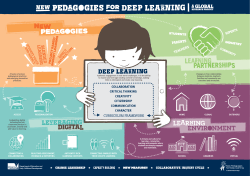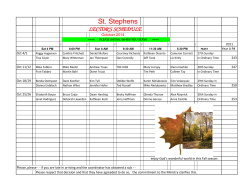
Technological, Pedagogical, Content Knowledge (TPACK) Handout
Introducing TPACK Technological Pedagogical Content Knowledge Punya Mishra & Matthew Koehler Michigan State University What is TPACK? Technological Pedagogical Content Knowledge (TPACK) attempts to capture some of the essential qualities of knowledge required by teachers for technology integration in their teaching. At the heart of the TPCK framework, is the complex interplay of three primary forms of knowledge: Content (C), Pedagogy (P), & Technology (T) and their intersections. Considering the intersections we get: - Pedagogical Content Knowledge (PCK): Taking P and C together, we get knowledge of pedagogy that is applicable to the teaching of specific content - Technological Content Knowledge (TCK) – At the intersection of T and C is the knowledge of the relationship between technology and content - Technological Pedagogical Knowledge (TPK) - the existence, components and capabilities of various technologies as they are used in the settings of teaching and learning And finally, at the intersection of all three knowledge domains is - Technological Pedagogical Content Knowledge (TPCK) – The intersection of all three components characteristic of true technology integration and the negotiation of the relationships between these three components of knowledge. True technology integration is understanding and negotiating the relationships between these three components, as they play out in specific contexts. A teacher capable of negotiating these relationships represents a form of expertise different from, and greater than, the knowledge of a disciplinary expert (say a mathematician or a historian), a technology expert (a computer scientist) and a pedagogical expert (an experienced educator). Effective technology integration for pedagogy around specific subject matter requires developing sensitivity to the dynamic, transactional, relationship between all three components. There is no single technological solution that applies for every teacher, every course, or every view of teaching. Rather, solutions lie in the ability of a teacher to flexibly navigate the spaces defined by these key elements. The critical role of teacher creativity: Most technological tools (think word-processors or compasses) have not been designed for educational purposes. Moreover the rapid rate of technology change (think Web 2.0 services on hand held devices) leads to increasing pressure on teachers to keep up with these new tools and devise new ways to integrate them in their teaching. This means that teachers need to go beyond “functional fixedness” and instead need to creatively repurpose these tools to make them pedagogically viable. This requires a deep understanding not just of the technology but also of the content to be covered, the pedagogical approaches to be supported and the contexts within which teaching/learning is to happen. Situational creativity, flexibility, tolerance for ambiguity, and a desire to “play” are key attributes of the TPACK knowledge teachers need to develop for successful technology integration in the 21st century. Developing TPACK Standard approaches that treat technology skill development in isolation from content and pedagogy will not work. There are a range of ways in which TPACK development can be fostered (both for pre-service and in-service teachers). Two are listed below (more can be found at the resources given below): 1. The Learning Technology by Design (LT/D): The LT/D approach argues that it is necessary to teach technology in contexts that honor the rich connections between technology, the subject matter (content), and the means of teaching it (the pedagogy). In this approach, teachers work collaboratively in design teams to solve authentic pedagogical problems. 2. TPACK-based activity types as a technique for professional development of teachers. This technique emphasizes domain specific activity types and argues that this may authentically and effectively assist teachers’ and teacher educators’ technology integration efforts. Key Readings What is it? Mishra, P., & Koehler, M. J. (2006). Technological Pedagogical Content Knowledge: A new framework for teacher knowledge. Teachers College Record. 108(6), 1017-1054. AACTE Committee on Innovation and Technology (2008). The handbook of technological pedagogical content knowledge for educators. AACTE and Routledge, NY, New York. [Chapter 1: Introducing TPACK.] Koehler, M. J., Mishra, P., Kereluik, K., Shin, T.S., & Graham, C. (2013). The Technological Pedagogical Content Knowledge Framework. in M. J. Spector, M. D. Merrill, J. Elen, & M. J. Bishop (Eds.) Handbook of Research on Educational Communications and Technology. Fourth Edition. Springer, NY. p. 101-111. TPACK Videos by Punya Mishra: http://punya.educ.msu.edu/research/tpck/tpack-videos/ How do we measure it? Koehler, M. J., Shin, T.S., & Mishra, P. (2011). How do we measure TPACK? Let me count the ways. In R. N. Ronau, C.R. Rakes, & M. L. Niess (Eds.). Educational Technology, Teacher Knowledge, and Classroom Impact: A Research Handbook on Frameworks and Approaches. Information Science Reference, Hershey PA. How do we develop it? Koehler, M.J., Mishra, P., Bouck, E. C., DeSchryver, M., Kereluik, K., Shin, T.S., Wolf, L.G. (2011). Deep-Play: Developing TPACK for 21st Century Teachers. International Journal of Learning Technology, Vol. 6, No. 2. 146-163. Harris, J., Mishra, P., & Koehler, M. (2009). Teacher's technological pedagogical content knowledge: Curriculum-based technology integration reframed. Journal of Research on Technology in Education, vol. 41, no. 4, PP. 393-416. TPACK & Creativity Mishra, P., & Koehler, M. J. (2009). Too Cool for School? No Way! Learning & Leading with Technology, (36)7. 14-18. Mishra, P., Koehler, M. J., & Kereluik, K. (2009). The song remains the same: Looking back to the future of educational technology. TechTrends, 53(5), 48-53. Mishra, P., Koehler, M. J., & Henriksen, D. (2011). The seven trans-disciplinary habits of mind: Extending the TPACK framework towards 21st century learning. Educational Technology 51(2), 22-28. Learning More & Getting Involved All TPACK all the time: http://www.tpack.org TPACK Bibliography: http://www.mendeley.com/groups/522011/tpack/papers/ TPACK SIG @ SITE & TPACK newsletter Newsletter archive and subscription info available at http://punya.educ.msu.edu/tpack/ Punya Mishra’s (punya@msu.edu) blog on technology, creativity, design, and yes, TPACK Web: http://punyamishra.com/ Matthew J. Koehler’s (mkoehler@msu.edu) All Things TPACK page Web: http://mkoehler.educ.msu.edu/tpack/ © Punya Mishra (punya@msu.edu) & Matthew Koehler (mkoehler@msu.edu
© Copyright 2025









![This article was downloaded by: [176.9.124.142] Publisher: Taylor & Francis](http://cdn1.abcdocz.com/store/data/000214599_1-fc254b706ceb75175cc8c0c45e042a94-250x500.png)

